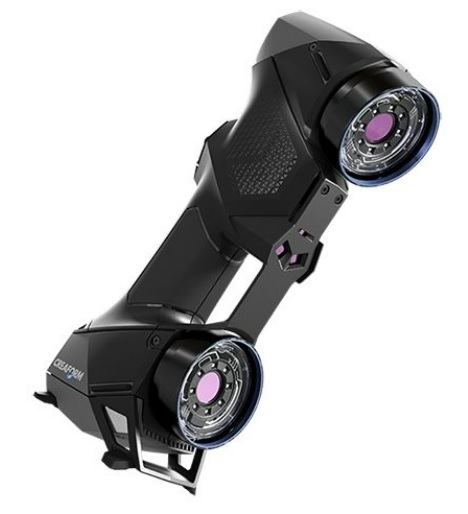Industrial 3D scanners are playing an essential role in improving product development processes by integrating with 3D printers. Using advanced technology your team will effortlessly capture precise and detailed digital representations of physical objects enhancing accurate reproduction.
Industrial 3D scanners offer a turnkey solution for manufacturers and engineering firms to quickly and effectively carry out projects and other industrial applications.
Industrial 3D scanners combined with 3D printers will become a powerhouse for manufacturers to swiftly create prototypes, iterate designs, and test functionality before committing to full-scale production.
Use a streamlined development process that will accelerate time and reduce costs. Users have the ability to scan existing objects, this is reverse engineering, and now it’s possible to reproduce complex components.
By generating models from existing objects, companies can leverage the potential of 3D scanner-3D printer combos to revamp designs, create new parts, or manufacture spare parts for end users. Combining industrial 3D scanners and 3D printers opens up endless possibilities, enhancing the overall efficiency and innovation in product development across various industries.
How to Select the Right 3D Scanner for Your Needs
Compare low-cost and industrial-grade scanners.
Industrial scanners are faster and easier to set up, like the Go!SCAN 3D. Accuracy matters, especially in manufacturing. Industrial-grade scanners such as HandySCAN 3D offer precise results (0.050 mm) for realistic models.
Scan Resolution and Versatility The resolution of a 3D mesh is a critical factor to consider when choosing a 3D scanner. Low-resolution STL files can result in uneven and pixelated prints, affecting the quality of your 3D models. A scanner’s ability to provide a higher mesh resolution is closely tied to its capacity to detect small details and maintain overall accuracy. Industrial-grade scanners, such as the Go!SCAN, offers remarkable resolutions of up to 0.100 mm, significantly surpassing the scan resolution capabilities of lower-end scanners. Versatility is equally important; high-end 3D scanners can capture data from a wide range of materials, shapes, colors, and sizes. In contrast, lower-end scanners may struggle with materials like machined parts and dark-colored surfaces, potentially limiting their applicability in industrial settings.
The Role of Versatility When selecting a 3D scanner, it’s crucial to ensure it can handle the diverse range of parts and components commonly encountered in industrial applications. A scanner’s ability to capture data from various materials and surfaces is a testament to its versatility. High-end 3D scanners excel in this aspect, enabling you to scan objects of different shapes, colors, and sizes without compromising on data accuracy. This versatility is a significant advantage, as it ensures your scanner can adapt to the ever-changing needs of your projects, allowing you to maintain efficiency and precision in your scanning processes.
Simplified Post-Processing with Industrial-Grade Scanners: Furthermore, industrial-grade 3D scanners often come equipped with user-friendly software that simplifies the finalization of scan data for 3D printing. One such example is software like VXmodel, which streamlines the editing of meshes, and generation of NURBS surfaces, and ensures best-fit alignments. These advanced features empower users to refine their CAD files, resulting in the highest-quality printed models. Industrial-grade scanners not only capture data with precision but also facilitate the seamless transition from scanning to 3D printing, enhancing the overall efficiency and output quality of your projects.
The Key to Making the Best Decision Is Knowing Your Needs
In the quest to select the perfect 3D scanner to complement your 3D printer, time is of the essence. Defining your specific requirements is the first step toward informed decision-making. Remember, the choice of a 3D scanner hinges on the exact nature of your industrial applications.
For those immersed in basic, non-industrial pursuits or pursuing hobbies, low-end 3D scanners may suffice—for now. However, if you’re an engineer or designer tackling industrial projects that demand the utmost precision in 3D models and parts, the urgency to consider industrial-grade 3D scanners cannot be overstated. These cutting-edge devices offer unparalleled levels of accuracy, resolution, and software capabilities that are simply indispensable. While it’s true that they may entail a more significant initial investment, their performance and the substantial return on investment they deliver are undeniable.
For comprehensive insights on using industrial 3D scanners in 3D printer projects, we recommend visiting the Creaform 3D Blog. There, you’ll find valuable knowledge and expertise to enhance your understanding of this field. Additionally, if you’re interested in purchasing these advanced products, you can conveniently do so through Willrich Precision Company, a trusted manufacturer and distributor in the industry. Don’t hesitate; take the first step towards 3D printing excellence by exploring the blog and product offerings today!
Don’t wait! Contact Willrich Precision Company today for a consultation and live demonstrations of industrial 3D scanners. Your path to excellence in 3D printing and modeling begins here, and time is of the essence in securing your competitive edge.






